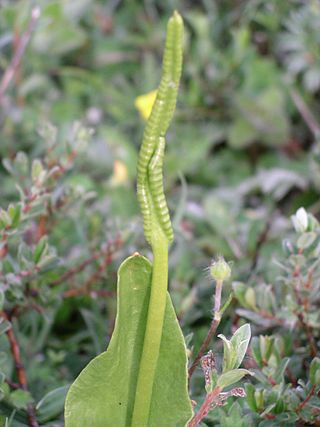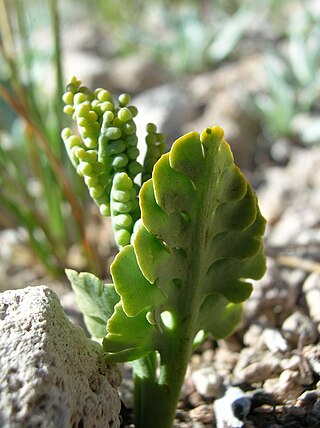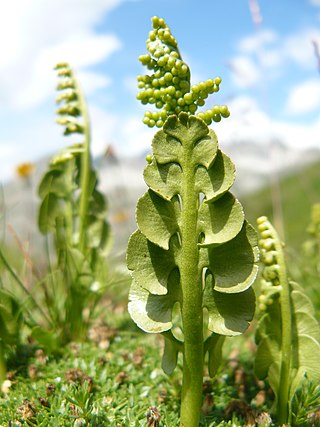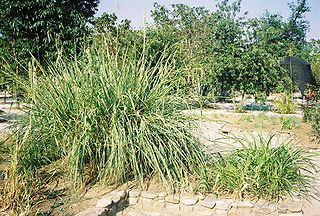
Ophioglossaceae, the adder's-tongue family, is a small family of ferns. In the Pteridophyte Phylogeny Group classification of 2016, it is the only family in the order Ophioglossales, which together with the Psilotales is placed in the subclass Ophioglossidae. The Ophioglossidae are one of the groups traditionally known as eusporangiate ferns. Members of the family differ from other ferns in a number of ways. Many have only a single fleshy leaf at a time. Their gametophytes are subterranean and rely on fungi for energy.

Botrychium is a genus of ferns, seedless vascular plants in the family Ophioglossaceae. Botrychium species are known as moonworts. They are small, with fleshy roots, and reproduce by spores shed into the air. One part of the leaf, the trophophore, is sterile and fernlike; the other, the sporophore, is fertile and carries the clusters of sporangia or spore cases. Some species only occasionally emerge above ground and gain most of their nourishment from an association with mycorrhizal fungi.

Sceptridium is a genus of seedless vascular plants in the family Ophioglossaceae, closely allied to the genus Botrychium. It is also closely related to the genus Botrypus. Sceptridium species are commonly called the grape-ferns.

Botrypus virginianus, synonym Botrychium virginianum, sometimes called rattlesnake fern is a species of perennial fern in the adders-tongue family. It is monotypic within the genus Botrypus, meaning that it is the only species within the genus. It is called the rattlesnake fern in some parts of North America, due to its habit of growing in places where rattlesnakes are also found. Rattlesnake fern prefers to grow in rich, moist woods in dense shade and will not tolerate direct sunlight.

Hallingskarvet National Park is a national park in central Norway that was established by the government on 22 December 2006. The park is located in the municipalities of Hol, Ulvik and Aurland. More precisely, the park comprises the Hallingskarv plateau and the high mountain areas to the west of it. It includes the Vargebreen glacier as well as the valleys of Såtedalen, Lengjedalen, Ynglesdalen, and parts of Raggsteindalen.

Botrychium pumicola, with the common name pumice moonwort, is a rare fern.
Cotylelobium lanceolatum is a tree in the family Dipterocarpaceae. The specific epithet lanceolatum means "lance-like", referring to the shape of the leaf.

Alisma lanceolatum is a species of aquatic plant in the water plantain family known by the common names lanceleaf water plantain and narrow-leaved water plantain. It is widespread across Europe, North Africa and temperate Asia. It is naturalized in Australia, New Zealand, Oregon, California and British Columbia. It is considered a noxious weed in some places.

Botrychium lunaria is a species of fern in the family Ophioglossaceae known by the common name moonwort or common moonwort. It is the most widely distributed moonwort, growing throughout the Northern Hemisphere across Eurasia and from Alaska to Greenland, as well as temperate parts of the Southern Hemisphere.

Botrychium minganense is a species of fern in the family Ophioglossaceae known by the common name Mingan moonwort. It is native to North America from Alaska and northern Canada to Arizona, where it is uncommon throughout most of its range, appearing at scattered spots in coniferous forests and marshy areas such as swamps.

Tripsacum is a genus of plants in the grass family and native to the Western Hemisphere. Gamagrass is a common name for plants in this genus.

Sceptridium dissectum is a common fern in the family Ophioglossaceae, occurring in eastern North America. Like other plants in this group, it normally only sends up one frond per year. It has long been the subject of confusion because the frond presents in one of two forms, either the normal form that resembles other plants in the genus, or the skeletonized form.

Sedum lanceolatum is a species of flowering plant in the family Crassulaceae known by the common names spearleaf stonecrop and lanceleaf stonecrop.

Botrychium matricariifolium is a species of fern in the Ophioglossaceae family. It is referred to by the common names chamomile grape-fern, daisyleaf grape-fern, and matricary grape-fern. It is native to Europe and parts of eastern North America, including eastern Canada and parts of the United States.

Symphyotrichum lanceolatum is a species of flowering plant in the family Asteraceae native to North America. Common names include panicled aster, lance-leaved aster, and white panicled aster. It is a perennial, herbaceous plant that may reach 1.5 meters tall or more, sometimes approaching 2 m. The lance-shaped leaves are generally hairless but may feel slightly rough to the touch on the top because of tiny bristles. The flowers grow in clusters and branch in panicles. They have 16–50 white ray florets that are up to 14 millimeters long and sometimes tinged pink or purple. The flower centers consist of disk florets that begin as yellow and become purple as they mature.

Donella lanceolata is a plant species in the family Sapotaceae. It is a tree growing up to 30 metres (100 ft) tall, with a trunk diameter of up to 40 cm (16 in). The bark is grey to dark brown. Inflorescences bear up to 45 flowers. The fruit are brownish to purplish black, ripening yellow, round, up to 4 cm (2 in) in diameter. Its habitat is lowland forests from sea level to 700 metres (2,300 ft) altitude. Its natural range is Madagascar, India, Sri Lanka, Thailand, Cambodia, Laos, Vietnam, Malaysia, Brunei, Indonesia, the Philippines, Papua New Guinea, the Solomon Islands and Queensland.

Japanobotrychum is a genus of ferns in the family Ophioglossaceae with the sole species Japanobotrychum lanuginosum. The genus is accepted in the Pteridophyte Phylogeny Group classification of 2016, but not by some other sources.

















